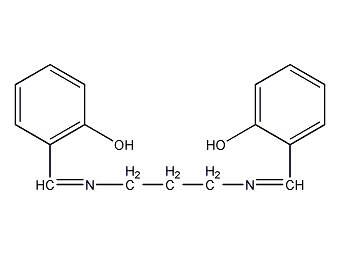N,N’-Disalicylidene-1,3-propanediamine N,N’-Bis(salicylidene)-1,3-propanediamine


Structural formula
| Business number | 03CN |
|---|---|
| Molecular formula | C17H18N2O2 |
| Molecular weight | 282.34 |
| label |
N,N’-Salicylaldehyde propylenediamine, N,N’-disalicylidene-1,3-diaminopropane, N,N’-Aqueous disalicylate-1,3-diaminopropane, N,N’-disalicylicaldehyde-1,3-propanediamine, 1,3-Bis(o-hydroxybenzylideneamino)propane, 2-((E)-[((E)-3-([(E)-(2-Hydroxyphenyl)methylidene]amino)propyl)imino]methyl)phenol, alpha,alpha’-(Trimethylenedinitrilo)di-o-cresol, Disalicylicenepropanediamine, Disalicylidene-1,3-propanediamine, disalicylidenepropa, Heterocyclic compounds |
Numbering system
CAS number:120-70-7
MDL number:MFCD00002245
EINECS number:204-418-6
RTECS number:None
BRN number:2057483
PubChem number:24855082
Physical property data
None yet
Toxicological data
1, acute toxicity: rat oral LD50: 1g/kg
Mouse oral LD50: 1070mg/kg
Mouse peritoneal cavity LD50: 117mg/kg
Mouse subcutaneously LD50: 225mg/kg
Rabbit subcutaneous LD50: 790mg/kg
2, other multiple dose toxicity: livestock TDLO: 350mg/kg/4W-I
3, tumorigenic toxicity: mice subcutaneously TDLO: 1000mg/kg/25W-I
Ecological data
None yet
Molecular structure data
5. Molecular property data:
1. Molar refractive index: 83.60
2. Molar volume(m3/ mol):253.2
3. isotonic ratio(90.2K):651.9
4. Surface Tension(dyne/cm):43.9
5. Dielectric constant:
6. Dipole moment(10 -24cm3):
7. <SPAN style="FONT -SIZE: 9pt; FONT-FAMILY: 宋体; mso-ascii-font-family: Arial; mso-han��Area (TPSA):58.2
7. Heavy atoms Quantity: 21
8. Surface charge :0
9. Complexity :538
10. Number of isotope atoms:0
11. Determine the number of atomic stereocenters:0
12. Uncertain number of atomic stereocenters:0
13. Determine the number of stereocenters of chemical bonds:2
14. Uncertain number of chemical bond stereocenters:0
15. Number of covalent bond units: 1
Properties and stability
None yet
Storage method
None yet
Synthesis method
None yet
Purpose
None yet
0 level1 lfo1; tab-stops: list 18.0pt” align=left>13. Determine the number of stereocenters of chemical bonds:2
14. Uncertain number of chemical bond stereocenters:0
15. Number of covalent bond units: 1
Properties and stability
None yet
Storage method
None yet
Synthesis method
None yet
Purpose
None yet